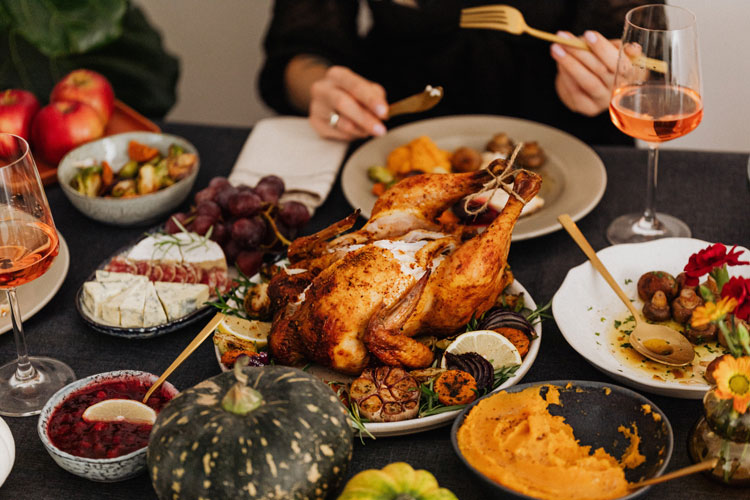Food and Culture In Depth
Introduction to Food and Culture
America: A Culinary Melting Pot
Think about what you’ve eaten this month. If you’re like many Americans, your meals include a dizzying array of different foods–from spaghetti bolognese to pad thai to sushi, you can travel the world with your taste buds! Traditional foods are also a huge part of many important American holidays such as Thanksgiving. It’s easy to take food-based traditions and access to diverse cuisines for granted, but our culture of food reflects a huge amount about our national history–you could say that the story of our food is the story of America itself!

Introduction
Thanksgiving

What do turkey, cranberry sauce, and pumpkin pie make you think of? These are foods we eat on Thanksgiving. As you dine with your family, you might pause to reflect that while we need food to survive, it means much more than that. We are social creatures, and the foods we eat and even how we eat them are part of our culture.

The story of the “first” American Thanksgiving began in December of 1620, when the Pilgrims, sailing on the Mayflower, arrived at Plymouth in what is now Massachusetts.
During the first winter, half of the original 102 passengers and many of the ship’s crew died of malnutrition and disease.
In the spring of 1621 English-speaking Native Americans taught the Pilgrims how to grow corn, catch fish and tap maple trees for sap, helping the Pilgrims survive. To celebrate their first harvest, the Pilgrims held a feast in the fall of 1621, and were joined by members of the Wampanoag tribe.
Although the Pilgrim-Wampanoag feast was legendary, it was never repeated. In fact, Thanksgiving was not nationally recognized again until 1777, when the United States revolutionary government announced a day of thanksgiving to celebrate winning the Battle of Saratoga during the Revolutionary War. The holiday was not celebrated nationally again until 1789, when President George Washington designated a one-time Thanksgiving holiday to honor the acceptance of the United States Constitution.

Did you know that the writer of the song, “Mary Had a Little Lamb” helped put Thanksgiving on our calendars? Sara Joseph Hale, known as the “Godmother of Thanksgiving,” was a famous writer and magazine editor in the 1800s. In 1827 Hale began a crusade to establish Thanksgiving as a yearly holiday. She published articles and recipes about Thanksgiving and wrote letters to politicians and presidents. Hale thought that the holiday would help unify the nation. Two presidents ignored her, but in 1863, in the midst of the Civil War, President Abraham Lincoln issued a proclamation putting Thanksgiving on the final Thursday of November every year.
Thanksgiving did not become a legal holiday until 1941, when President Franklin Delano Roosevelt signed into a bill into law putting Thanksgiving on every fourth Thursday of November.
Thanksgiving Today
With an estimated population of over 326 million people from all corners of the earth, the United States is a far cry from its origins. Because so many people from different parts of the world call America home, Thanksgiving has become a symbol of how this country welcomes newcomers seeking a better life. In return, immigrants have contributed to the mosaic of cultures that is America.
A Country of Immigrants
The Ever-Changing Food Culture in the United States
Have you ever been invited to a friend’s house for dinner and experienced something new? Perhaps your friend’s family was from India and served you chicken marinated in spicy yogurt and the flatbread, naan? Or you might have visited an Israeli or Lebanese friend and tasted hummus, the tangy chickpea dip made with garlic, lemon and sesame paste?
If you or your parents are from another country, maybe you have been the one to introduce your friends to a new dish.
Even if you don’t know anyone from another country, you can still sample food from different cultures, either at an international festival, a restaurant, or by making a recipe at home.
Why are there so many different food cultures intertwined here? We are a nation of immigrants, also known as a “Melting Pot.”
What is the “Melting Pot”?
A melting pot is a country or society in which people from many different nations, religions and ethnic groups live together. When immigrants arrive in the United States, they often live in neighborhoods with people from the same country. Over time people and cultural traditions mix, creating a new culture. The process of immigrants becoming part of mainstream culture is called assimilation.
The first people to come to America included African, Spanish, French, English, and Dutch people. Each group strongly influenced American culture.
However, as many people from India, Africa and Asia now also call America home, our culture keeps changing. If you look at American food culture, you can see the footprints of many different peoples interacting and creating something new.
The Great Migration: 1850 to 1920
Prior to 1850, most immigrants to America were from England, Scotland, and Norway. Between 1850 and 1920, however, new groups started coming. Jewish migrants from Eastern Europe came to escape religious persecution, while Southern Italians, Irish and came to escape poverty. Japanese and Chinese also came looking for economic opportunities. All in all, over 27 million people entered the United States at this time.
Initially these groups settled in close-knit communities, often in the poorest sections of large cities. Such enclaves were called “Chinatown” and “Little Italy.” Each group brought its own food, religion and way of life.
Over time, these immigrant groups made unique contributions to American food and culture. However, the children and grandchildren of immigrants often left their neighborhoods and married people outside of their communities.
This is why on Thanksgiving we celebrate our diverse cultural roots while appreciating our national, collective identity. Here are a few examples of foods brought by immigrant groups who came to this country between 1850 and 1920.
The Southern Italian Influence
What’s for dinner tonight: spaghetti and tomato sauce, lasagna, or pepperoni pizza? Do your parents have a penchant for espresso, latte or cappuccino?
When four million Southern Italian immigrants came to the United States in the late 19th and early 20th centuries, they brought pasta, tomato sauce, Italian sausage, pizza and many other dishes. Americans soon grew to love all shapes of pasta with tomato or cream sauce, lasagna and, of course, pizza!
The flow of Italian immigrants to the United States has ebbed, but there are still pockets in cities such as Boston, St. Louis, New York City and San Francisco where the children, grandchildren and great-grandchildren of Italian immigrants live and continue to create the dishes that are beloved by an entire nation.
Eastern European Jewish Food
Have you ever sat down to a breakfast of bagels with lox (smoked salmon) and cream cheese? Jewish bakers in New York City popularized the boiled and then baked circles of bread that are now ubiquitous in grocery stores and bakeries across the country. In a new land, they improvised and added cream cheese and lox.
Coming from the cold climate of Eastern Europe, Eastern European Jews also brought hearty chicken soup, potato latkes (potato pancakes), and rye bread, as well as the kosher dill pickle.
While Southern Italians were coming into the country, millions of Eastern European Jews were fleeing danger in Russia. Over two million came between 1880 and 1920, and settled, as did Italians, in the poor areas of large cities such as New York, Chicago and Philadelphia.
Nowadays many people don’t think of the bagel as Jewish food. It has become an integral part of our culture, along with egg rolls, pizza and fortune cookies. Of course, Polish bakers didn’t put chocolate chips, cinnamon or blueberries into their bagels, either.
The Chinese Influence
Are you in the mood for some Chinese food? How about shrimp fried rice, or stir-fried noodles with tofu and vegetables? Perhaps you are a fan of dim sum, which includes dumplings filled with shrimp, pork and chicken?
These dishes come from a type of Chinese cooking known as Cantonese, which hails from the Guangdong province of China. Chinese from Guangdong began coming to the United States in the 1850s to work in goldmines, build railroads, farm and work in many other capacities.
Some American workers resented the Chinese workers because they competed for the same jobs, so in the 1880s, the United States closed the door on Chinese immigration. This policy continued until 1943, when President Franklin Delano Roosevelt repealed the law as a gesture to the Chinese who were U.S. allies in World War II.
By the 1970s, Chinese from many different provinces flocked to the United States, bringing with them, among other things, the spicy cuisine of Sichuan.
Sichuan: Mouth-Numbingly Spicy
Known for its liberal use of red chilis, cloves, garlic and a special type of peppercorn that makes the mouth go numb, Sichuan (also spelled “Szechuan”) dishes include kung pao chicken, a spicy, stir-fried chicken with peanuts and vegetables, and dry fried green beans.
The Surprising Origin of the Fortune Cookie
If you have gone to a Chinese restaurant, undoubtedly you are familiar with the ritual of receiving a fortune cookie at the end of a meal. The fortune cookie is a folded sweet wafer with a slip of paper inside containing a prediction, advice, and lucky numbers. These sweets are popular all over the world, but not in China.
Until several years ago the cookie had murky origins. Some said that a Chinese noodle maker in America invented the fortune cookie. However, the folded wafer so closely resembles a Japanese cookie known as senbei that it is now believed to be of Japanese origin. Like its American counterpart, the Japanese cookie also has a paper fortune, but the Japanese bakers (who still make the cookies in Japan) were afraid their customers would eat the paper, and so they tucked it neatly into the folds of the cookie.
How did the cookie appear in American Chinese restaurants? In the early 20th century many Japanese immigrants in California owned Chinese restaurants, and it is believed that they introduced the cookies to American customers. Chinese-owned restaurants picked up on the trend, and it spread from California across the nation.
The Raw Power of Japanese Food
Japanese food is one of the most popular ethnic foods in America. Who can resist the sweet and saltiness of chicken teriyaki served over rice, or the comfort of a bowl of udon (thick wheat noodles) in savory broth with seaweed, or the sweetness of sushi rice combined with crab and avocado in a California sushi roll? But, it was not always so.
Between 1886 and 1911, 400,000 Japanese immigrated to the United States, settling predominantly in Hawaii and California. Like their European counterparts, they came seeking economic opportunity. The Japanese introduced flavors such as teriyaki, a sauce made by mixing rice wine and soy sauce; tempura, a fluffy batter used to coat fried shrimp and vegetables; and a meat-and-tofu dish called sukiyaki.
However, it was not until the 1970s and 1980s that eating raw fish, either wrapped in a seaweed roll or on top of rice, took off in the United States. Refrigeration made transporting the fish possible, and sushi bars popped up all over the country.
After the Great Migration
More recent additions to the American Palate
Following the Great Migration, in 1920, over one third of the people in the United States were immigrants. However, many Americans felt threatened by the newcomers, so in the 1920s the U.S. government passed laws preventing Asians and Africans from immigrating and limiting the number of Eastern European Jews and Italians who could immigrate. The Great Migration was over.
The doors did not reopen until 1965, when the United States passed the Immigration Act of 1965, a law allowing people of all ethnicities to come to the United States. This law forever changed the face of America and the food we enjoy. Here are some examples of foods brought by immigrants over the past 50 years.
Ethiopian Cuisine
Have you ever gone to dinner where you didn’t use utensils, but scooped up spicy and stews and vegetable dishes with a spongy flatbread known as Injera? Chances are you were enjoying food from Ethiopia, a country in East Africa.
The Ethiopian national dish, Wot, is a spicy stew made with chicken, beef, goat or lentils seasoned with berbere, a blend of chili powder and spices Injera is a flatbread, similar to a pancake, made with the grain teff rather than wheat.
Since the 1970s, Ethiopians have become one of the largest African groups coming to the United States. Over 200,000 Ethiopians now live in the United States.
Indian
In 1960, just 12,000 immigrants from India lived in the United States. By 2015, there were over 2.4 million, making Indians the second largest group of immigrants to the United States after Mexicans.
Pungent, spicy Indian cuisine with curries and aromatic spices has dazzled people around the world. Have you ever tried chicken tikka masala, chicken served in a spicy, creamy tomato sauce over rice? This dish is so popular it is found in the frozen food sections of many grocery stores. Or, you might have tasted palak paneer, a dish similar to creamed spinach in which chunks of Indian cheese, called paneer, float in savory spinach. India chai, a spicy tea and milk drink served in many coffee bars, is another popular addition to the American menu.
With its warmth and spice, Indian food has a strong place in American food culture.
Korean
Since the 1970s, over one million South Koreans have settled in the United States, the largest population outside of South Korea. The largest communities are in California, New York and New Jersey, but the cuisine is popular throughout the country.
Koreans brought a new food vocabulary, including “bibimbap,” a dish of rice, covered by stir-fried meat and vegetables, topped with a fried egg and some hot sauce!
Another popular dish is Korean-style barbecue. “Bulgogi beef” is thin slices of beef marinated in a savory sauce, then stir-fried with vegetables and served over rice. Bulgogi beef is usually served with pickled cabbage with hot sauce, a Korean specialty called kimchi.
Regional Cuisine
For example, crayfish (or crawfish), the fresh water shellfish, is very popular in Louisiana, where crayfish are easily caught in the swamps of that region. Because many of the settlers in Louisiana were French, they used French methods to cook the crayfish.
Here are a few examples of American regional cuisine:
Louisiana Cajun and Creole Style Cooking
Before the great migration of the 1800s, Louisiana was its own melting pot.
Native Americans, Africans, French, Spanish, and Haitians all played a role in creating a diverse, thriving culture that made New Orleans unique among American cities.
One of the most well known dishes from Louisiana is gumbo, a dish with African, Native American, Spanish and French roots. The popular dish is a spicy stew traditionally made with crayfish, okra, and meat or sausage. Okra comes from Africa, while crayfish is a local delicacy. The stew is thickened with file, a powder made from the dried leaves of a sassafras tree, the Native American contribution. The base of the gumbo’s sauce, however, is a roux, a classic French method for making creamy sauces using butter and flour. This cosmopolitan dish is traditionally served over rice.
Soul Food
Soul Food describes the cuisine developed by African Americans in the southeastern United States. 13 African American cooks utilized food with African roots (such as black eyed peas and okra) alongside Native American staples like cornmeal to create rich, satisfying dishes.
Classic American dishes such as fried chicken, hush puppies (fried cornmeal dumplings), collard greens (a leafy vegetable) cooked with bacon or ham, and Hoppin’ John (black eyed peas cooked with rice and ham or bacon) are examples of African American cuisine that is now popular across the United States.
Tex-Mex
When you think of Mexican food, what comes to mind? Do you think about nachos, fajitas, or chili con carne (chili with meat)?
Food experts say that what Norte Americanos think of as “Mexican” foods are really a fusion of Northern Mexican and Texas cattle ranchers’ cuisine. Unlike authentic Mexican food, Tex-Mex cuisine uses beef, wheat flour, sour cream and cheddar cheese, ingredients not typical of traditional Mexican food.
Regardless of its roots, Tex-Mex cuisine has introduced Americans to key flavors and ingredients of the Maya and Aztecs, Native American tribes in Central America. We will be forever grateful for the avocado dip guacamole, corn tortillas, chili peppers, and the cocoa bean, flavors that make everyday eating exciting.
Fusion Food: A Tradition of Mash-Ups
Tex-Mex cuisine, Soul Food and Cajun/Creole style cooking are all examples of fusion foods, when one or more cultures mix to create new flavors.
Because so many cultures have come together in the United States, “Fusion Food” has become its own style of cooking. For example, putting guacamole on a hamburger combines American and Mexican foods. Korean style tacos, with Korean barbecued beef and sautéed cabbage in a taco shell with salsa, are another example of a popular mash-up. Fusion cooking like this has become so popular that it is considered its own style of cuisine.
The Result
A Varied and Dynamic Food Culture
Since the Pilgrims landed in 1620, America has been a place where food cultures mix with delicious results. With so many different types of food to choose from, eating is an adventure. Don’t be afraid to try new flavors! Go to an international festival, or try cooking something new at home. One of the easiest ways to travel is through your taste buds.
Citations
- Avey, T. (2012, September 5). Discover the History of Sushi. PBS.
https://www.pbs.org/food/the-history-kitchen/history-of-sushi/. - Bethune, M. (2019, April 17). What’s the Difference Between Tex-Mex and Mexican Food?
Serious Eats. https://www.seriouseats.com/2014/05/draft-tex-mex-and-mexican.html - Fayed, S. (n.d.). The Most Popular Middle Eastern Foods. The Spruce Eats.
https://www.thespruceeats.com/popular-middle-eastern-foods-2355798 - Guardian News and Media. (2003, October 12). The Brit who saved Mexican food. The Guardian.
https://www.history.com/topics/immigration/u-s-immigration-before-1965. - History.com Editors. (2009, October 29). U.S. Immigration Before 1965. History.com.
https://www.history.com/topics/immigration/u-s-immigration-before-1965. - Lynn, A. (n.d.). What Makes a Dish Authentic Soul Food? The Spruce Eats.
https://www.thespruceeats.com/soul-food-history-and-definition-101709 - Mexican Versus Tex-Mex Food: What’s the Difference? NDTV Food. (2017, September 20).
https://food.ndtv.com/food-drinks/mexican-versus-tex-mex-food-whats-the-difference-1752897. - National Geographic. (2021, February 10). Top 10 Foods of the Maya World — National Geographic. Travel. https://www.nationalgeographic.com/travel/article/maya-foods.
- Parkinson, R. (n.d.). Learn More About Chinese Cantonese Cuisine and Recipes. The Spruce Eats. https://www.thespruceeats.com/about-cantonese-cuisine-694173
- Romer, M. (n.d.). All About Gumbo: the Classic Louisiana Dish. TripSavvy.
https://www.tripsavvy.com/new-orleans-gumbo-recipe-1604785. - Zollman, J. (2017, May 19). Jewish Immigraion to America: Three Waves. My Jewish Learning. https://www.myjewishlearning.com/article/jewish-immigration-to-american-three-waves/


